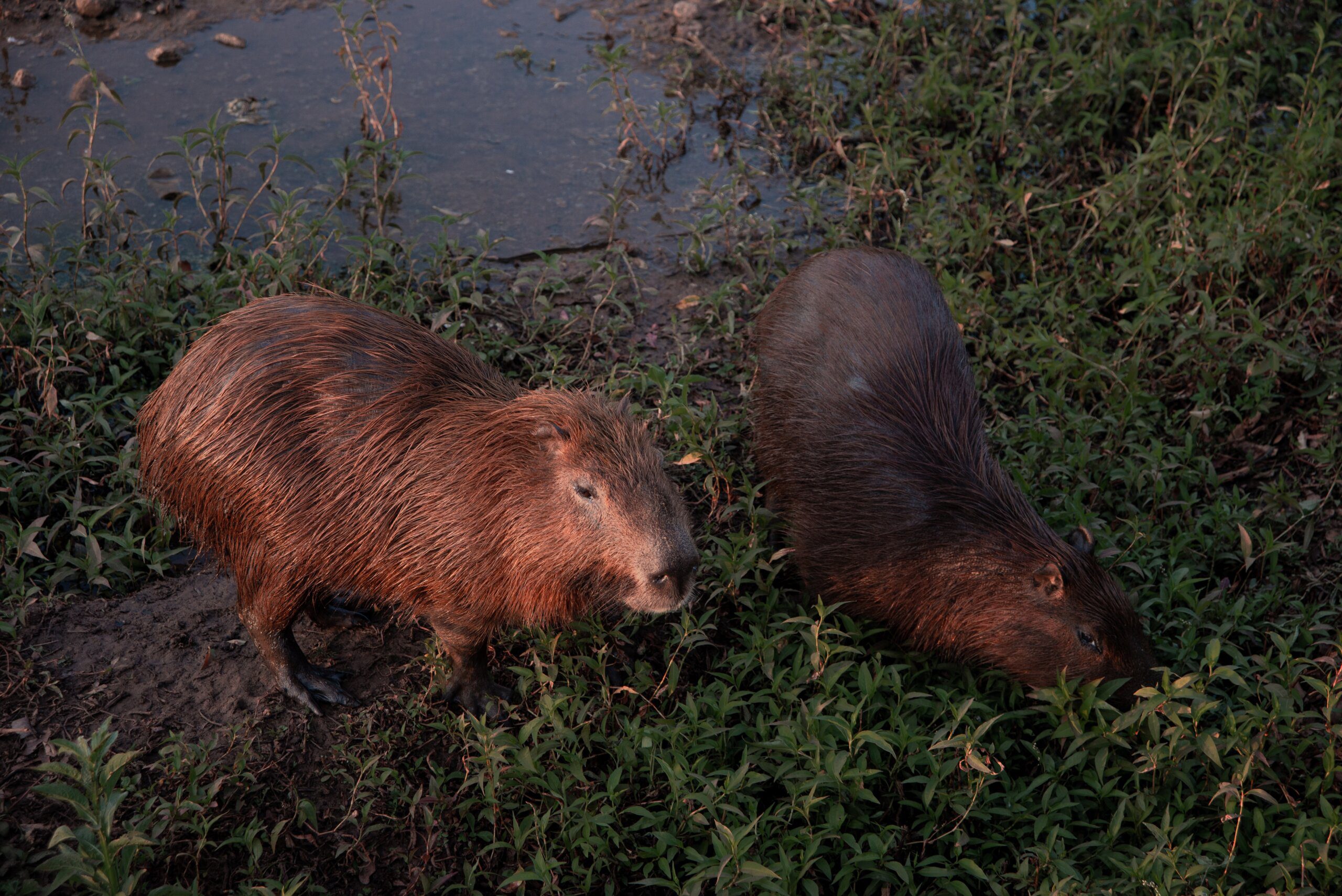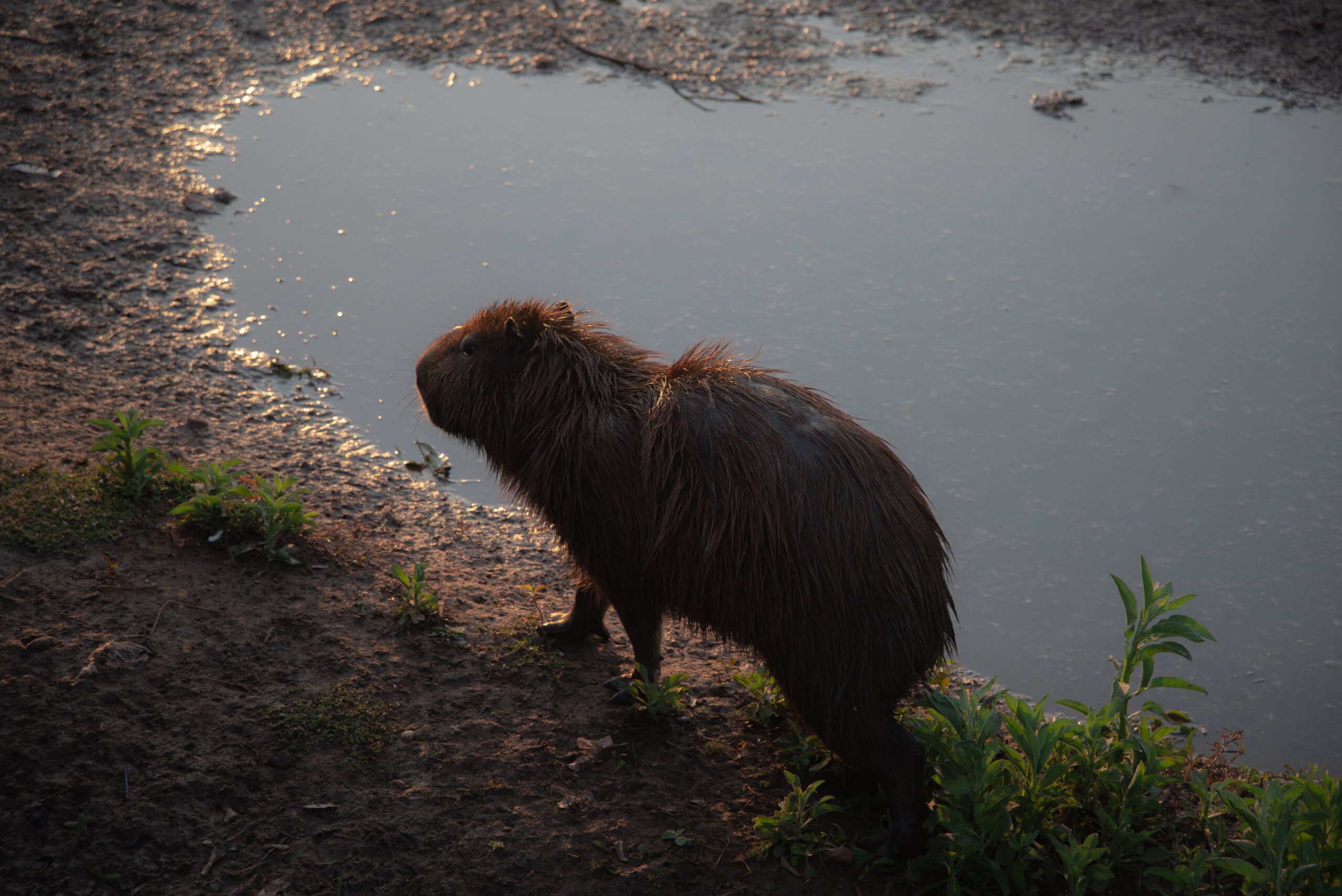In a world where friendships are cherished, there exists a creature known as the friendly capybara, a true friend to all. With its friendly demeanor and gentle nature, this fascinating creature has captured the hearts of many. Whether it’s bonding with fellow capybaras or forming unlikely friendships with other animals, the capybara has earned its reputation as a social and affectionate companion. Discover the fascinating world of the friendly capybara and learn why it has become a beloved friend to creatures big and small.

Physical Description
Size
The capybara is the largest rodent in the world, measuring about 1 to 1.5 meters (3 to 4.5 feet) long and weighing between 35 and 66 kilograms (77 to 145 pounds). They have a robust and barrel-shaped body, with short legs and a long, tapered muzzle.
Appearance
Capybaras have a unique appearance with short, coarse hair that ranges in color from reddish-brown to dark brown, which helps them blend into their natural environment. Their bodies are relatively hairless, except for a sparse coat on their backs. Their eyes are small and dark, and their ears are rounded and inconspicuous.
Physical Abilities
Although they may appear slow, capybaras are surprisingly agile. They have adapted to a semi-aquatic lifestyle and are excellent swimmers. They have partially webbed feet that allow them to navigate easily through water, making them highly suited to their habitats. Capybaras can also run quite fast on land, reaching speeds of up to 35 kilometers per hour (22 mph).
Habitat
Native Range
Capybaras are native to South America, where they can be found in a variety of countries including Brazil, Argentina, Venezuela, and Colombia. They primarily inhabit regions with abundant water sources such as rivers, swamps, marshes, and flooded grasslands.
Habitat Preference
Capybaras are highly adaptable and can thrive in a variety of habitats as long as there is access to water. They prefer areas with mixed vegetation, including grasses, reeds, and shrubs, which provide them with both food and cover. These social creatures are often found in large groups near water bodies, where they can graze, swim, and socialize.

Social Behavior
Group Structure
Capybaras are highly social animals and live in groups known as herds or bands. These herds typically consist of 10 to 40 individuals, although larger groups have been observed in areas with abundant resources. These groups are typically led by a dominant male, while the females and offspring form the core of the herd.
Communication
Capybaras use a variety of vocalizations and body language to communicate with each other. They emit different sounds, including whistles, barks, and purrs, to convey different messages to their group members. They also use scent marking through glands located around their noses and anogenital area to mark territory and communicate their social status.
Playful Nature
Capybaras are known for their playful behavior, often engaging in games and social interactions with each other. They can be seen grooming each other, chasing one another in the water, or even lying together in a cuddling pile. This playful nature extends to their interactions with other species, including humans and even other animals.
Diet
Herbivorous Diet
Capybaras are herbivores, meaning they feed exclusively on plant matter. Their diet primarily consists of grasses, aquatic vegetation, and a variety of other plant species. They spend a significant amount of time foraging for food, grazing on both land and in the water, using their sharp and constantly growing incisors to efficiently consume vegetation.
Favorite Plants
While capybaras are known to eat a wide range of plants, they have certain preferences. They particularly enjoy water hyacinth, duckweed, and tender grasses. These plants provide essential nutrients, moisture, and contribute to their overall well-being. Additionally, they have a unique adaptation that allows them to extract nutrients from cellulose-rich plant material using specialized microorganisms residing in their large intestine.

Reproduction
Breeding Season
Capybaras typically have a breeding season during the rainy months, which varies depending on the region. During this time, males compete for females by engaging in aggressive displays and vocalizations. Once a male establishes dominance, he will mate with multiple females within the herd.
Gestation Period
The gestation period for capybaras is approximately 130 to 150 days, averaging around five months. Females usually give birth to a litter of two to eight pups, with an average litter size of four to five. The newborns are precocial, meaning they are relatively mature and mobile at birth, with open eyes and the ability to walk within hours.
Litters
After giving birth, the female capybara will nurse her young for several weeks. Within a few days, the young capybaras can follow their mother and join the herd. They will continue to nurse for a couple of months but will also start sampling solid foods as they grow. The young capybaras reach sexual maturity between 10 and 16 months, and females often stay within their natal herds while males tend to disperse.
Interaction with Humans
Domestication and Ownership
While capybaras are not typically domesticated, they have been kept in captivity for various purposes. They have a long history of being raised in South American countries, primarily for their meat and fur. However, in recent years, they have gained popularity as exotic pets in some regions, captivating people with their friendly nature.
Capybara as Pets
Capybaras can make extraordinary pets for the right owners. They are intelligent, sociable, and trainable. However, owning a capybara requires a considerable commitment as they have specific habitat and dietary needs. It is crucial to provide them with ample space, access to water, and a balanced diet to ensure their well-being. Due to their social nature, it is recommended to keep more than one capybara to prevent loneliness.
Therapy Animals
Capybaras also have a therapeutic role in some contexts. Their friendly and calm disposition makes them suitable for animal-assisted therapy programs. Capybaras have shown to have a comforting effect on individuals struggling with anxiety, stress, or certain medical conditions. These gentle giants can help provide emotional support and promote overall well-being.
Capybara and Other Animals
Relationship with Dogs
Capybaras have been known to form unique bonds with other animal species, including dogs. Their sociable nature allows them to interact positively with dogs, often engaging in playful activities together. However, it is crucial to supervise their interactions and ensure the dog is well-trained and friendly, as capybaras are sensitive and may react negatively to aggressive behavior.
Interaction with Other Wildlife
In their natural habitats, capybaras coexist with a variety of other wildlife species. They play a crucial role in the ecosystem as herbivores, shaping the vegetation and providing a valuable food source for predators such as jaguars, caimans, and large birds of prey. Capybaras actively participate in maintaining the delicate balance of their habitats.
Threats and Conservation
Hunting
Capybaras face various threats, primarily from hunting activities. In some regions, they are hunted for their meat, fur, and even for their perceived medicinal properties. This hunting pressure, when unsustainable, can negatively impact capybara populations and disrupt the natural balance of their ecosystems.
Habitat Loss
Habitat loss is another significant concern for capybara populations. As human populations expand and agricultural activities intensify, wetlands, grasslands, and other vital capybara habitats are being converted or fragmented. This loss of suitable habitat reduces their available resources, puts pressure on their populations, and can lead to a decline in their numbers.
Conservation Efforts
Various organizations and individuals are working towards the conservation of capybaras and their habitats. Efforts include establishing protected areas, conducting research on capybara populations, and promoting sustainable hunting practices. Additionally, educational programs and initiatives aim to raise awareness about the importance of preserving capybaras as well as their habitats.
Famous Capybaras
Caplin Rous
Caplin Rous, an affectionate and intelligent capybara, gained fame through social media. His adorable pictures and videos showcased the gentle and friendly nature of capybaras, capturing the hearts of millions of people worldwide. Caplin Rous played a significant role in raising awareness about capybara conservation and highlighting their potential as pets.
JoeJoe the Capybara
JoeJoe the Capybara is another renowned capybara who gained popularity on social media. With his charming personality and memorable antics, JoeJoe quickly became an internet sensation. Followers enjoy watching him interact with his diverse group of friends, including dogs and other wildlife.
Fun Facts about Capybaras
The World’s Largest Rodent
Capybaras hold the distinction of being the largest rodents in the world. Their impressive size and unique appearance make them stand out. Despite their size, these gentle giants are surprisingly friendly and docile.
Semiaquatic Abilities
Capybaras are expert swimmers and inhabit semi-aquatic environments. Their partially webbed feet and streamlined bodies allow them to glide through the water with ease, whether they’re seeking refuge from predators or simply enjoying a leisurely swim.
Natural Mosquito Repellent
The capybara’s habit of wallowing in mud and water serves a practical purpose: protection against pesky mosquitoes. The layer of mud and water on their fur acts as a natural repellent, providing relief from these bothersome insects. This behavior also helps regulate their body temperature and maintain their skin’s health.
In conclusion, the capybara is a fascinating and friendly creature that captivates the hearts of many. Its unique physical traits, social behavior, and importance in the ecosystem make it a truly remarkable animal. Whether as pets, therapy animals, or ambassadors for conservation, capybaras continue to enchant and bring joy to all those who come in contact with them.



